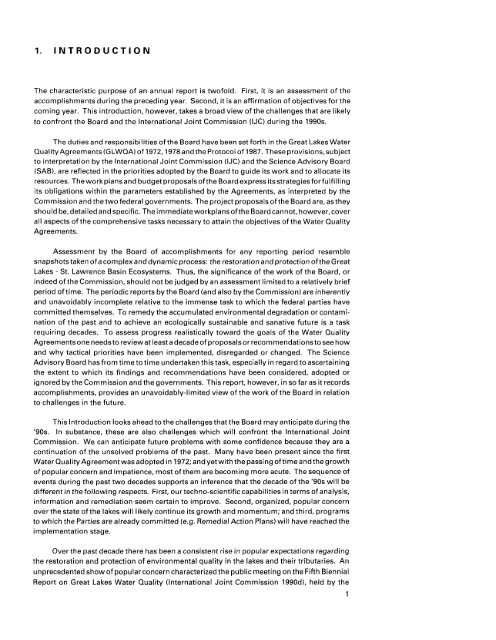International Joint Commission
International Joint Commission
International Joint Commission
Create successful ePaper yourself
Turn your PDF publications into a flip-book with our unique Google optimized e-Paper software.
1. INTRODUCTION<br />
The characteristic purpose of an annual report is twofold. First, it is an assessment of the<br />
accomplishments during the preceding year. Second, it is an affirmation of objectives for the<br />
coming year. This introduction, however, takes a broad view of the challenges that are likely<br />
to confront the Board and the <strong>International</strong> <strong>Joint</strong> <strong>Commission</strong> (IJC) during the 1990s.<br />
The duties and responsibilities ofthe Board have been set forth in the Great Lakes Water<br />
Quality Agreements (GLWQA) of 1972,1978 and the Protocol of 1987. These provisions, subject<br />
to interpretation by the <strong>International</strong> <strong>Joint</strong> <strong>Commission</strong> (IJC) and the Science Advisory Board<br />
(SAB), are reflected in the priorities adopted by the Board to guide its work and to allocate its<br />
resources. The work plans and budget proposals ofthe Board express itsstrategiesforfulfilling<br />
its obligations within the parameters established by the Agreements, as interpreted by the<br />
<strong>Commission</strong> and the two federal governments. The project proposals of the Board are, as they<br />
should be,detailed andspecific. The immediateworkplansofthe Boardcannot, however,cover<br />
all aspects of the comprehensive tasks necessary to attain the objectives of the Water Quality<br />
Agreements.<br />
Assessment by the Board of accomplishments for any reporting period resemble<br />
snapshots taken of a complex and dynamic process: the restoration and protection of the Great<br />
Lakes - St. Lawrence Basin Ecosystems. Thus, the significance of the work of the Board, or<br />
indeed of the <strong>Commission</strong>, should not be judged by an assessment limited to a relatively brief<br />
period oftime. The periodic reports bythe Board (and also bythe <strong>Commission</strong>) are inherently<br />
and unavoidably incomplete relative to the immense task to which the federal parties have<br />
committed themselves. To remedy the accumulated environmental degradation or contamination<br />
of the past and to achieve an ecologically sustainable and sanative future is a task<br />
requiring decades. To assess progress realistically toward the goals of the Water Quality<br />
Agreementsone needs to review at least a decade of proposals or recommendations to see how<br />
and why tactical priorities have been implemented, disregarded or changed. The Science<br />
Advisory Board has from time to time undertaken this task, especially in regard to ascertaining<br />
the extent to which its findings and recommendations have been considered, adopted or<br />
ignored by the <strong>Commission</strong> and the governments. This report, however, in so far as it records<br />
accomplishments, provides an unavoidably-limited view of the work of the Board in relation<br />
to challenges in the future.<br />
This Introduction looks ahead to the challenges that the Board may anticipate during the<br />
'90s. In substance, these are also challenges which will confront the <strong>International</strong> <strong>Joint</strong><br />
<strong>Commission</strong>. We can anticipate future problems with some confidence because they are a<br />
continuation of the unsolved problems of the past. Many have been present since the first<br />
Water Quality Agreement was adopted in 1972; and yet with the passing of time and the growth<br />
of popular concern and impatience, most of them are becoming more acute. The sequence of<br />
events during the past two decades supports an inference that the decade of the '90s will be<br />
different in the following respects. First, our techno-scientific capabilities in terms of analysis,<br />
information and remediation seem certain to improve. Second, organized, popular concern<br />
over the state of the lakes will likely continue its growth and momentum; and third, programs<br />
to which the Parties are alreadycommitted (e.g. Remedial Action Plans) will have reached the<br />
implementation stage.<br />
Over the past decade there has been a consistent rise in popular expectations regarding<br />
the restoration and protection of environmental quality in the lakes and their tributaries. An<br />
unprecedented show of popular concern characterized the public meeting on the Fifth Biennial<br />
Report on Great Lakes Water Quality (<strong>International</strong> <strong>Joint</strong> <strong>Commission</strong> 1990d), held by the<br />
1

















